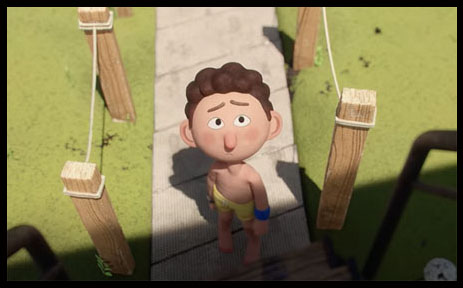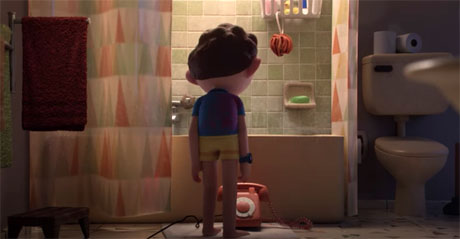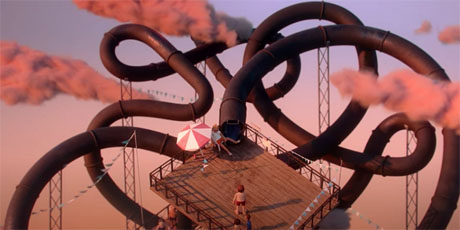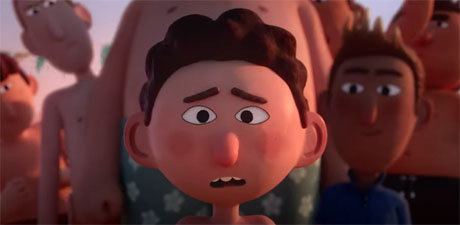
Uri Lotan is the director of Black Slide, one of the 15 finalists for this year’s Best Animated Short Film Academy Award. It’s based on true events from his childhood. A boy named Eviah is nervous about going down a massive, black slide at a water park. But there’s more that’s on his mind. Lotan shares with me how his personal experiences greatly influenced his comedy-drama short. (This Animation Scoop Q&A was edited for length and clarity.)
Uri Lotan: It’s been a crazy ride so far. It feels amazing. It’s incredible. It’s an amazing honor to be amongst such awesome films and to see all this exposure. Everybody’s coming from all these different countries, with different types of films. It’s super exciting and quite a whirlwind. It’s been awesome.

Jackson Murphy: That’s great to hear. This short is about courage. How did you feel you had the courage to tell this very personal story in the ways that you wanted to?
UL: That’s a great question. It was something I was struggling with for a while. It is a very personal story. I can see how it’s a tool, in a way, to create a conversation and to talk about something that is painful for me but for other people, they could relate. I was kind of torn about it for a while. How do you make this story interesting for other people? It was very close to me. And I was also afraid of the potential melodramatic aspect. I didn’t want it to just be violins and the whole thing to be about sadness. The personal aspect of the film is the plotline that happens at the house — the phone line, the cable and him bringing it in the bathroom. All of that is kind of autobiographical. It pretty much happened. I always thought it was sort of interesting and puzzled by it. It was a real moment.
For many years I carried that, but I didn’t feel like I had the other side of that. In real life, I also spent that day in a water park having a great time with my friends. All of that was real, but there was nothing real to kind of grab onto that I could show it. In real life, I remember being in the wave pool… and when you’re at a water park, it’s the best day of your life, basically, as a little kid. I remember the waves hitting and everybody having the best time, and I just kind of submerged under the wave pool and was looking above. Everyone’s having the most fun and I’m a little removed from that. But there was no other aspect of it.
When I was living in Vancouver, there was a moment where I thought about when I was in elementary school. You’d get your flu shot by going to see the nurse and you’d sit outside of her office in a little line with a few kids. You’d walk up, going into the room, shut the door and then you would hear a scream, depending on the kid. Maybe it’s gonna be painful — your mind starts racing. And I was like, “Oh, that’s kind of like waiting in line for a slide in a water park.” Once I had those two… building blocks of the film, there’s now a balance. It’s now fun… I want it to be fun and engaging. I like nostalgic kid films, like “Stand By Me”. I’m that kid. I really like that aspect of it. Once I had those two pillars, I think I felt much more comfortable moving forward, where I didn’t feel like it was just this sad thing. I show a sliver of optimism. It took the shape I felt comfortable in sharing this story — capturing that day but at the same time, it also helps the audience feel it in the same way.

JM: You do a great job of balancing heaviness with nostalgic fun, and you do it in a unique way. I also found it interesting while watching this that Eviah sort of has this feeling during the day and during the water slide experience of something [being] wrong. I’m fascinated by that idea, because I believe in feeling that maybe something bad or unfortunate is going to happen and then it sort of does — and remembering that experience and remembering where you were. The way you dig into that is very interesting.

Uri Lotan
JM: Yeah, it connected with me for sure. The animation is fantastic. And it is CG but it looks like stop-motion. At first I thought it was stop-motion. Tell me about the technique that you get with this. It’s very well done.
UL: Thank you so much. The film is CG but it tries to look like stop-motion. The idea was: we’re bringing in this childish, almost children’s illustrations design world. Very simple, graphic, fun and whimsical. But we wanted to balance that. I think a lot of the nostalgia is that. You’re getting these frames that are very simple and clear and they tell you where to look. That’s all fun. But at the same time, we wanted to give a realness to it, an almost dark side. A slightly more adult point of view. Stop-motion, in how tactile and real it is, kind of makes things more grounded. The light that comes and can create real drama — the way it’s executed adds a lot of dimension to everything.
Where that really works is whenever we have a close-up of these characters. I wanted to do that live-action close-up where an actor is almost doing nothing and you’re like, “Wow. That was the best shot in the film. It told me everything.” I like that filmmaking, where a lot of the understanding comes from your interpretation, and a lot of things are left for you to figure out and imagine what the character is going through. That gives a little bit of freedom to the viewer — project yourself and put yourself in Eviah’s shoes. And it also gave us a lot of advantages to embrace imperfections. The animation could be a little more imperfect and less polished.

UL: And more important than anything, with an independent film with a short schedule, it let us use our time in animation on blocking and having a lot of time there and less time on [being] polished. And it was okay. The style lends itself to it. And it gave me the opportunity to really figure out the acting the way we wanted to. A lot of style choices [and limited time]… result in just as much of an impact, keeping personality and delivering what we’re trying to say within a frame that fits our needs. The texturing work was from an Israeli artist who’s working in Manchester — Yuval Turgeman did all the incredible shading, which was crucial for this process. And Eidan Elgrably did the lighting. Both of them took it and made it look so much better than I thought it would. A lot of people can’t tell if it’s stop-motion or not, which is incredible.
JM: Was preparing for the slide sequence as daunting as Eviah getting up there and being so nervous about going down it?
UL: Great question. Yes. I think so. It’s one of those scenes where I had to really figure it out. I have to sculpt it. It was super daunting because you’re building up to something, and a lot of times when you’re building up to something it disappoints. So you definitely don’t want to disappoint. I had to figure out the story of what happens in there. It was very crucial. I think it was a hard scene for a lot of people to envision. Even in storyboards it was hard to completely grasp. It was a leap of faith. It went from many iterations. But it was also one of the more experimental parts of the film. For most of the film we had very clear storyboards and designs of everything. Every scene meticulously illustrated from one point of view that we just stuck to and modeled from that point of view.

UL: For the slide we had a little bit of art, but it was never completely figured out. We had to find it and sculpt it. One of the earlier things that I did… these slides actually exist. They’re kind of like cut-outs. I took a bunch of footage from YouTube and I cut this little two-minute thing of a kid going into a water slide and going into it, with music, and coming out of it and plunging out and the phone ringing. Pretty much what I had in mind. This is super helpful — to buy into it and believe in it. And even for other people.
JM: What would it mean to you to possibly be an Academy Award nominee — to get to go to the 95th Academy Awards? How would you feel about all of that?
UL: It would be incredible. I think it would be a really amazing boost of confidence to continue making films — at the biggest, highest level. It is amazing to do something from your heart, from your purest heart. And I can be tough on myself, because I know where it comes from and how personal it is for me. I always knew this is very pure to me and from the core of my soul. It’s very humbling and a huge boost of confidence that I was able to talk with all these viewers who are watching this film. We managed to talk about this thing — I could tell them a little something and they could tell me something back and we got each other and understood each other. I would just hope I have more opportunities to create films and projects like this.
- INTERVIEW: Strap In For “Mars Express” - April 30, 2024
- INTERVIEW: Jeff Fowler On “Knuckles” And “Sonic 3” - April 22, 2024
- INTERVIEW: “Inside Out 2” Director And Producer On Pixar Sequel - April 16, 2024


 January 14th, 2023
January 14th, 2023  Jackson Murphy
Jackson Murphy  Posted in
Posted in  Tags:
Tags: 






